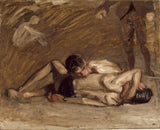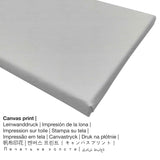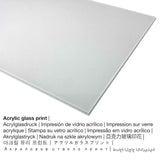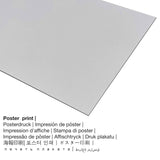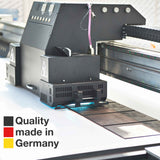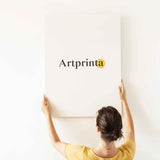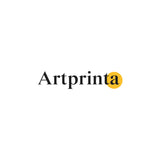Thomas Eakins, 1899 - Ndị mgba mgba - mbipụta nka mara mma
Ụtụ gụnyere. Mbupu gbakọrọ na ndenye ọpụpụ.
Nkọwapụta nka dị ka ewepụtara site na webụsaịtị ihe ngosi nka (© Nwebiisinka - nke Los Angeles County Museum of Art - Ebe ngosi nka nke Los Angeles County)
In Paris Eakins had been thoroughly trained in the academic system of preparing extensive studies before beginning a major painting. He practiced this approach all his life and taught it to his pupils. Before undertaking his paintings of the boxers and other athletes that he painted at the end of the 1890s, Eakins spent hours watching the men, studying their movements in light of his knowledge of anatomy. He posed two wrestlers in the Quaker City Athletic Club and in his studio, where in May 1899 several photographs were taken. The man on top is Joseph McCann, a wrestler and champion boxer. He is posed holding his opponent in a half nelson and crotch hold, potentially close to winning. Eakins copied the photograph of this pose almost directly onto a canvas, 1899 (Philadelphia Museum of Art), the purpose of which would have been to clarify the details of musculature that were unclear in the photograph. The next step in the preparatory process was the museum's small oil painting, which served as a compositional sketch. In it the artist worked out the placement of the figures in the composition of the finished canvas Wrestlers, 1899, also owned by the LACMA. Eakins made some slight changes in the positions of the wrestlers, especially in the right leg of the lower man and in the head and shoulders of the upper man. Eakins's main interest was in placing them in relation to the figures he was now introducing, the lower body of an observer or referee on the right and a man at a rowing machine in the upper left. The short white line at the referee's foot represents the rope that marked off the boundaries of the wrestling arena. The men were nude in the photograph and initial figure study but wear trunks in the large finished version. The black area in the museum's sketch that looks as though it might represent trunks probably is only an indication of an area of shadow. Athletes in the period wore light-colored trunks that were cut very high over the hips as seen in the finished painting. Achieving the proper balance within the composition was especially important to Eakins at this point in his career, because of his increased awareness of surface design and internal structure. Like most artists at the turn of the century Eakins introduced into his paintings devices that had the effect of compromising the illusion of depth while creating a more even, overall, decorative pattern; in this example he did so by the placement of the rower in the extreme upper left corner and by cropping the standing man with the top edge of the painting, which pulls what is normally the part farthest away into the same plane as that of the foreground figures of the wrestlers. William Preston Harrison bought the oil sketch upon the advice of CHILDE HASSAM, when it was exhibited in Los Angeles.
nkọwapụta
The artwork "Wrestlers" was made by the nwoke onye na-ese ihe Thomas Eakins n'afọ 1899. Ihe okike izizi tụrụ nha: 16 1/16 x 20 1/16 na (40,8 x 50,96 cm). Mmanụ na kwaaji was applied by the painter as the technique for the painting. Today, the artwork is included in the digital art collection of Ebe ngosi nka nke Los Angeles County. a nkà nke oge a ngalaba ọha artwork gụnyere na n'ikike nke Ụlọ ihe ngosi nka nke Los Angeles County (www.lacma.org).In addition to that, the artpiece has the following creditline: . In addition to this, the alignment of the digital reproduction is in odida obodo usoro ma nwee oke nke 1.2: 1, nke pụtara na ogologo bụ 20% ogologo karịa obosara. Thomas Eakins was a photographer, painter, sculptor, art educator, whose style can primarily be attributed to Realism. The North American artist lived for 72 afọ and was born in 1844 in Philadelphia, Philadelphia county, Pennsylvania, United States and died in the year 1916.
Nhọrọ akụrụngwa ngwaahịa
Na nhọrọ mwepu ngwaahịa ị nwere ike ịhọrọ ngwa na nha dabere na mmasị gị. Ị nwere ike ịhọrọ nha na ihe kachasị amasị gị n'ime nhọrọ ndị a:
- Mbipụta iko acrylic (nke nwere ezigbo mkpuchi iko n'elu): An acrylic glass print, which is sometimes described as a an art print on plexiglass, changes your favorite artwork into wonderful wall décor. Your own version of the artwork will be made with modern UV printing technology.
- Ebipụta akwụkwọ mmado na ihe akwa akwa: The Artprinta poster print is a printed canvas paper with a slight surface texture. The poster print is ideally designed for putting your art replica with the help of a special frame. Please keep in mind, that depending on the absolute size of the poster we add a white margin of around 2-6cm round about the work of art in order to facilitate the framing with a custom frame.
- Metal (aluminium debond mbipụta): Aluminium Dibond prints are prints on metal with an impressive depth. The white and bright parts of the artpiece shine with a silky gloss but without the glow. The colors are vivid and luminous, fine details appear very clear, and there’s a matte appearance that you can literally feel.
- Mbipụta kanvas: The canvas print is a printed canvas stretched on a wood frame. The advantage of canvas prints is that they are relatively low in weight. This means, it is quite simple to hang your Canvas print without the support of any wall-mounts. A canvas print is suitable for all types of walls.
Data omenka ahaziri ahazi
| Ihe nkiri: | Thomas Eakins |
| Aha utu aha: | C.D. Cook, Eakins Thomas Cowperthwaite, Cook C.D., Eakins Thomas Cowperthwait, Eakins Thomas, Thomas Eakins, Eakins |
| okike nke onye nka: | nwoke |
| Obodo onye nka: | American |
| Ọrụ: | art educator, photographer, sculptor, painter |
| Obodo obibi: | United States |
| nhazi ọkwa: | omenkà nke oge a |
| styles: | Ihe ngosi |
| Akwụsị: | 72 afọ |
| Afọ amụrụ: | 1844 |
| Obodo amụrụ: | Philadelphia, Philadelphia County, Pennsylvania, Njikota Obodo Amerika |
| Nwụrụ n'afọ: | 1916 |
| Ebe ọnwụ: | Philadelphia, Philadelphia County, Pennsylvania, Njikota Obodo Amerika |
Iberibe ozi ndabere nka
| Aha nke ọrụ nka: | "Wrestlers" |
| nhazi ọkwa: | sere |
| Otu izugbe: | nkà nke oge a |
| Time: | 19th narị afọ |
| Emepụtara na: | 1899 |
| Afọ nka: | ihe karịrị 120 afọ |
| Ihe osise izizi: | mmanụ na kwaaji |
| Akụkụ izizi: | 16 1/16 x 20 1/16 na (40,8 x 50,96 cm) |
| Ụlọ ihe ngosi nka: | Ebe ngosi nka nke Los Angeles County |
| Ebe ngosi nka: | Los Angeles, California, Njikota Obodo Amerika |
| Ibe weebụ: | www.lacma.org |
| Ụdị ikike nka: | ngalaba ọha |
| Site n'aka: | Ụlọ ihe ngosi nka nke Los Angeles County (www.lacma.org) |
Ngwaahịa a
| Nkewa ngwaahịa: | nka nka |
| Usoro mmeputakwa: | dijitalụ mmeputakwa |
| Production usoro: | Mbipụta UV ozugbo |
| Production: | arụpụtara na Germany |
| Stockdị ngwaahịa: | mmepụta ihe na-achọ |
| A na-atụ aro iji ngwaahịa eme ihe: | mgbidi mgbidi, ihe ndozi ụlọ |
| Nhazi nka nka: | usoro odida obodo |
| Njikwa oyiyi: | 1.2: 1 (ogologo: obosara) |
| Nsonaazụ: | ogologo bụ 20% ogologo karịa obosara |
| Nhọrọ akụrụngwa: | akwụkwọ mmado (akwụkwọ kwaaji), mbipụta ọla (aluminium dibond), mbipụta kanvas, mbipụta iko acrylic (nwere ezigbo mkpuchi iko) |
| Ọdịiche dị n'okirikiri akwa akwa akwa (akwa akwa): | 60x50cm - 24x20", 120x100cm - 47x39" |
| Mbipụta iko acrylic (nke nwere ezigbo mkpuchi iko): | 60x50cm - 24x20", 120x100cm - 47x39" |
| Nhọrọ nke mbipụta akwụkwọ mmado (akwụkwọ kwaaji): | 60x50cm - 24x20", 120x100cm - 47x39" |
| Mbipụta nke aluminom: | 60x50cm - 24x20", 120x100cm - 47x39" |
| Nhazi mbipụta nka: | ngwaahịa anaghị emebi emebi |
Ederede iwu dị mkpa: We try to depict the products as clearly as possible and to showcase them visually on the different product detail pages. Nonetheless, the tone of the printing material, as well as the printing might differ somehwat from the image on your device's monitor. Depending on your settings of your screen and the quality of the surface, not all colors can be printed one hundret percent realistically. Since our art reproductions are processed and printed manually, there may as well be minor variations in the motif's size and exact position.
© Nwebiisinka nke | Artprinta.com

